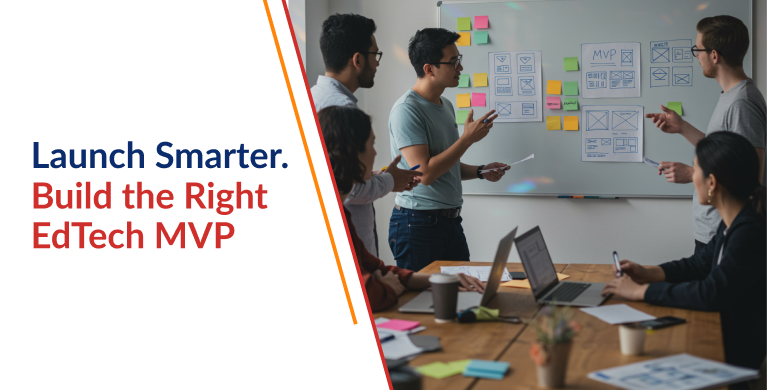
You Don’t Need to Build Everything, Just the Right Things
More than 90% of startups fail, and in the EdTech space, the stakes are even higher. You’re not just launching a product, you’re entering a sector deeply rooted in trust, usability, and measurable outcomes. While the desire to build a comprehensive platform right away is tempting, starting with a well-defined MVP (Minimum Viable Product) is often what separates successful launches from stalled ones.
Why? Because your MVP isn’t just a version of your product, it’s a learning tool. It’s how you validate your idea, engage early users, and gather the insights needed for smart EdTech product development.
So, what exactly should you prioritize in your first version? In this guide, we’ll break it down step-by-step, helping you focus on what matters in your MVP, from sector alignment to long-term vision.
Step 1: Ground Your EdTech MVP in Real Educational Needs
The best EdTech tools solve real problems, not hypothetical ones. Before writing a single line of code, ask:
- What specific pain points are we addressing for educators, learners, or administrators?
- How are these problems currently being solved (or not)?
- What would make users say, “This changes everything”?
Avoid the trap of feature overload in your MVP. Instead, focus on solving one core challenge exceptionally well.
For example, if your idea is a platform for school-parent communication, your MVP might only need direct messaging and automated announcements, not scheduling, attendance, and video conferencing from day one.
Step 2: Design an MVP for Education Software That’s Simple and Usable
In education, your users may include people with vastly different levels of tech comfort, from tech-savvy IT managers to time-pressed teachers or parents with limited access.
Your MVP should prioritize:
- Ease of use: Can someone navigate the platform without training?
- Accessibility: Does it work across devices, browsers, and with varying internet speeds?
- Clear UX flows: Is every action, like submitting homework or sending a message, intuitive?
The goal of your MVP for education software isn’t to impress with complexity; it’s to build trust through usability.
Insight: MVPs that reduce friction for the user have much higher adoption rates, especially in educational institutions like schools, where time is scarce and tech support may be limited.
Step 3: Choose Scalable Tech for Your EdTech Product Development
While your MVP should be lean, it must also be built on a scalable foundation. You don’t want to rewrite your entire platform once you grow from 2000 to 200,000 users.
Work with a tech partner who:
- Designs a modular architecture so new features can be added easily.
- Recommends cloud-based solutions for performance and uptime.
- Plans for data privacy and compliance from the start.
Even if you’re not launching in multiple countries today, it’s smart to think ahead about multilingual support, localization, and other factors that will enable you to grow without technical limitations. If you’re considering external development support, here’s why IT outsourcing helps EdTech startups grow efficiently and flexibly.
Step 4: Prioritize Communication & Feedback Features
The MVP phase is as much about gathering insights as it is about launching your product. Your MVP should include basic tools for:
- Tracking user behavior (e.g., most used features, common drop-off points).
- Collecting feedback directly from users (surveys, feedback buttons).
- Communicating with your early adopters (in-app messages, support channels).
This feedback loop is essential for your next phase of development. Building these touchpoints early will help you avoid false assumptions and guide your roadmap based on actual user needs.
Step 5: Plan Ongoing Support for Your EdTech Startup MVP
Your EdTech startup product roadmap shouldn’t stop at MVP launch; it’s where long-term support and iteration begin.
Make sure your development plan includes:
- Bug tracking and fast response systems.
- A clear agreement for post-launch technical support.
- A roadmap for iterative releases based on user feedback.
One of the biggest mistakes EdTech leaders make is treating the MVP as a standalone project. In reality, it’s your foundation, and maintaining its stability while building upon it is crucial to success. If you’re working with a distributed team, here are practical tips on how to manage a remote development team effectively after launch.
Step 6: Choose a Tech Partner with EdTech Experience
Not all software developers understand how education works, and this can lead to costly missteps. Look for a tech partner who:
- Has experience working with EdTech products.
- Understands the dynamics between leadership, IT, educators, and learners.
- Can offer proactive advice about workflows, user personas, and compliance.
A good tech partner won’t just follow your spec; they’ll challenge, refine, and improve your vision, based on real-world knowledge and a shared commitment to education. Here’s a guide to choosing the right tech partner for your EdTech project.
Conclusion: A Great Edtech MVP Isn’t Minimal, It’s Focused
Building an MVP for your EdTech product isn’t about cutting corners; it’s about making intentional decisions. When you focus on solving a clear problem, prioritize usability, and plan for long-term growth, your MVP becomes a launchpad rather than a limitation.
The education sector demands trust, clarity, and purpose. If your MVP reflects that from day one, you’re already on the right path.
Let’s Build It Together
At Pharos Solutions, we help EdTech founders turn ideas into functional, scalable MVPs. If you’re thinking about building your first version, we’d love to offer guidance or explore how we can collaborate.
Book a free discovery call today, let’s bring your EdTech vision to life.
Want to go deeper into your MVP planning? Check out our complete guide to building a successful EdTech product from the ground up.
Questions You May Have About EdTech MVP
What is an EdTech MVP?
An EdTech MVP (Minimum Viable Product) is a simplified version of an educational technology platform that includes only the core features needed to solve a specific problem and validate the idea with early users. It’s a strategic way to launch quickly, test the concept in real educational settings, and gather feedback before scaling.
Why should EdTech startups start with an MVP?
Building an MVP allows EdTech startups to reduce risk, save costs, and learn from real users early on. Instead of investing heavily in a full-featured platform, you test your idea in the market, adapt based on feedback, and gain faster traction. It’s the most effective path to product-market fit in education technology.
What features should I include in my EdTech MVP?
Your MVP should include only the must-have features that solve a specific pain point, like parent-teacher messaging, assignment submission, or learning progress tracking. Prioritize simplicity, usability, and responsiveness across devices. Avoid overloading your MVP; focus on features that directly support your product’s core promise.
How long does it take to build an EdTech MVP?
Most EdTech MVPs take 2 to 4 months to design, develop, and launch, depending on the scope and team size. Working with an experienced EdTech development partner can significantly speed up the process while ensuring your MVP is scalable and aligned with future goals.
How do I choose the right tech partner for my EdTech MVP?
Look for a software development partner with proven experience in the EdTech space who understands school workflows, user roles, and compliance needs. A strong partner won’t just build what you ask, they’ll guide your vision, recommend scalable solutions, and bring insights from similar EdTech projects.


